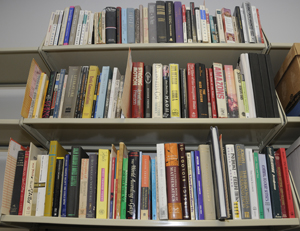

I didn’t think much of Infinite Jest in the beginning. My impression of David Foster Wallace’s writing was that it was wordy and unfocused with some seriously flawed characters. Gradually I settled into his use of language, which is quite impressive, and finally at the Boston AA section, I was hooked—certainly on the plot, but even more so on the man behind the prose. All at once, it was clear the length of the story and ambiguity of the characters was Wallace’s vehicle for articulating how unforgiving it is to be human, and how, though various generations may seem vastly different on the surface, they struggle internally with the same issues. I thought, this man is a genius; I want to know him better. So, I was thrilled to find out the Ransom Center would be acquiring his archive, especially given the description about the extensive annotations to his books.
Even then, I was not prepared for what we received. Of the more than 300 titles in his collection, there are maybe 10 or 15 that are not annotated—not simply with underlined passages but ample and personally revealing margin notes. The library basically falls into two categories: novels/stories he taught in his literature classes and books for use in research and self-analysis. Finishing Infinite Jest, I came away with a lot of questions about the origin of some of the characters, as well as theories about the story itself. I think the items in his library, which feel very much like journal entries the way he marked them up, provide some answers.
Looking at his collection, one can see that Wallace was undoubtedly a highly intelligent man: a philosopher, mathophile, physics buff, grammarian, pop-fiction reader, lit professor, creative writer, and spiritual seeker. He didn’t merely own these books; he digested them. Cover to cover there are handwritten notes and vocabulary words; he dog-eared pages, annotated the most pertinent passages, and even used the tomes as coffee mug coasters and phone conversation doodle pads. Through his books, one gains a sense of him on a personal, human level—his struggles, unpretentiousness, sense of humor, diligent research skills, and devotion to masterful writing. It’s almost as if he’s still teaching and sharing.